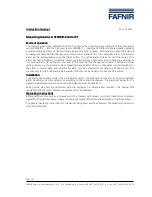
CC1000
SWRS048A Page 33 of 55
22. RSSI output
CC1000
has a built-in RSSI (Received
Signal Strength Indicator) giving an
analogue output signal at the RSSI/IF pin.
The
IF_RSSI
bits in the
FRONT_END
register enable the RSSI. When the RSSI
function is enabled, the output current of
this pin is inversely proportional to the
input signal level. The output should be
terminated in a resistor to convert the
current output into a voltage. A capacitor
is used in order to low-pass filter the
signal.
The RSSI voltage range from 0 – 1.2 V
when using a 27 k
Ω
terminating resistor,
giving approximately 50 dB/V. This RSSI
voltage can be measured by an A/D
converter. Note that a higher voltage
means a lower input signal.
The RSSI measures the power referred to
the RF_IN pin. The input power can be
calculated using the following equations:
P = -51.3 V
RSSI
– 49.2 [dBm] at 433 MHz
P = -50.0 V
RSSI
– 45.5 [dBm] at 868 MHz
The external network for RSSI operation is
shown in Figure 21. R281 = 27 k
Ω
, C281
= 1nF.
A typical plot of RSSI voltage as function
of input power is shown in Figure 22.
Figure 21. RSSI circuit
0
0.1
0.2
0.3
0.4
0.5
0.6
0.7
0.8
0.9
1
1.1
1.2
1.3
-105 -100 -95
-90
-85
-80
-75
-70
-65
-60
-55
-50
dBm
Voltage
433Mhz
868Mhz
Figure 22. RSSI voltage vs. input power
RSSI/IF
TO ADC
CC1000
R281
C281
RSSI/IF
TO ADC
CC1000
R281
C281
















































